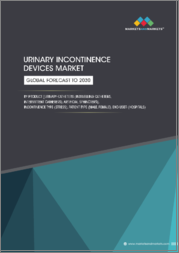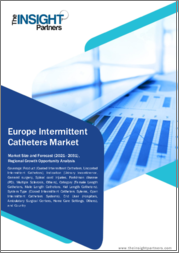
|
시장보고서
상품코드
1701905
간헐 카테터 시장 : 제품별, 적응증별, 카테고리별, 최종사용자별, 지역별(2025-2033년)Intermittent Catheters Market Report by Product, Indication (Urinary Incontinence, Surgery, Spinal Cord Injury, and Others), Category, End User, and Region 2025-2033 |
||||||
간헐 카테터 시장 세계 시장 규모는 2024년 29억 달러에 달했습니다. 향후 IMARC Group은 2033년까지 시장 규모가 49억 달러에 달할 것으로 예상하며, 2025-2033년 연평균 성장률(CAGR)은 5.72%에 달할 것으로 전망하고 있습니다. 이 시장은 의료 보험 적용 범위 확대, 카테터 삽입이 필요한 수술 건수 증가, 최소침습 수술에 대한 선호도 증가, 신경 질환의 유병률 증가, 카테터 설계의 급속한 기술 발전, 노인 인구의 증가가 주요 요인으로 작용하고 있습니다.
간헐 카테터 삽입술은 방광에서 소변을 배출하기 위해 카테터를 삽입하고 제거하는 시술입니다. 특발성 또는 신경인성 방광 과활동성(NDO) 기능 장애, 염증, 신경학적 상태, 약리학적 약물, 물리적 방광폐색 등으로 인해 불완전한 방광 배뇨를 보이는 환자에게 효과적인 방광 관리 전략입니다. 방광 팽창과 요로감염(UTI)을 예방하면서 사용하기 쉽고 편리합니다. 또한 누출, 막힘, 방광 경련을 피할 수 있기 때문에 간헐 카테터에 대한 수요가 전 세계적으로 증가하고 있습니다.
간헐 카테터 시장 동향:
현재 전 세계적으로 요로감염증(UTI) 및 요도폐색으로 고통받는 환자 수가 증가하고 있습니다. 이는 요로 및 생식 기관의 종양 증가와 함께 시장을 이끄는 중요한 요인 중 하나입니다. 또한, 방광염, 전립선 비대증, 신장 결석과 같은 비뇨기 질환의 유병률이 대중들 사이에서 증가하고 있는 것도 업계 투자자들에게 유리한 성장 기회를 제공하고 있습니다. 이 외에도 척수 손상, 다발성 경화증, 치매 등 다양한 질환에서 간헐 카테터에 대한 수요가 증가하고 있습니다. 이는 급성장하는 헬스케어 산업과 함께 시장 성장에 기여하고 있습니다. 또한, 시장의 주요 업체들은 연구 개발(R&D) 활동에 적극적으로 투자하고 있으며, 2차 감염으로부터의 보호를 강화하기 위해 온도 모니터링 기능이 있는 코팅된 요도 카테터를 도입하고 있습니다. 또한, 치료를 위해 의료기관을 방문할 수 없는 환자들을 위해 온라인 상담 및 안내를 제공하는 플랫폼도 출시하고 있습니다. 이와는 별도로, 친수성 항균 간헐 카테터와 같은 새로운 카테터에 대한 수요 증가가 시장 성장을 촉진하고 있습니다.
본 보고서에서 다루는 주요 질문
- 2024년 세계 간헐 카테터 시장 규모는?
- 2025-2033년 세계 간헐 카테터 시장의 예상 성장률은?
- 세계 간헐 카테터 시장을 이끄는 주요 요인은 무엇인가?
- COVID-19가 전 세계 간헐 카테터 시장에 미치는 영향은?
- 세계 간헐 카테터 시장의 제품별 분류는?
- 세계 간헐 카테터 시장의 적응증별 분류는?
- 세계 간헐 카테터 시장의 카테고리별 분류는?
- 세계 간헐 카테터 시장의 최종사용자별 분석은?
- 세계 간헐 카테터 시장의 주요 지역은?
- 세계 간헐 카테터 시장의 주요 플레이어/기업은?
목차
제1장 서문
제2장 조사 범위와 조사 방법
- 조사 목적
- 이해관계자
- 데이터 소스
- 1차 정보
- 2차 정보
- 시장 추정
- 상향식 접근
- 하향식 접근
- 조사 방법
제3장 주요 요약
제4장 소개
- 개요
- 주요 업계 동향
제5장 세계의 간헐 카테터 시장
- 시장 개요
- 시장 실적
- COVID-19의 영향
- 시장 예측
제6장 시장 내역 : 제품별
- 비코팅 간헐 카테터
- 코팅 간헐 카테터
- 주요 부문
- 항균성
- 친수성
- 기타
제7장 시장 내역 : 적응증별
- 요실금
- 수술(주요 수술)
- 척수 손상
- 기타
제8장 시장 내역 : 카테고리별
- 남성용 카테터
- 아동용 카테터
- 여성용 카테터
제9장 시장 내역 : 최종사용자별
- 병원
- 의료 연구 센터
- 외래 수술 센터
제10장 시장 내역 : 지역별
- 북미
- 미국
- 캐나다
- 아시아태평양
- 중국
- 일본
- 인도
- 한국
- 호주
- 인도네시아
- 기타
- 유럽
- 독일
- 프랑스
- 영국
- 이탈리아
- 스페인
- 러시아
- 기타
- 라틴아메리카
- 브라질
- 멕시코
- 기타
- 중동 및 아프리카
- 시장 내역 : 국가별
제11장 SWOT 분석
- 개요
- 강점
- 약점
- 기회
- 위협
제12장 밸류체인 분석
제13장 Porter's Five Forces 분석
- 개요
- 구매자의 교섭력
- 공급 기업의 교섭력
- 경쟁 정도
- 신규 참여업체의 위협
- 대체품의 위협
제14장 가격 분석
제15장 경쟁 구도
- 시장 구조
- 주요 기업
- 주요 기업 개요
- B. Braun Melsungen AG
- Becton Dickinson and Company
- Coloplast A/S
- Cure Medical LLC(Convatec Group plc)
- Hollister Incorporated
- Hunter Urology
- Medical Technologies of Georgia Inc.
- Pennine Healthcare Ltd.
- Teleflex Inc
- Wellspect Limited(Dentsply Sirona)
The global intermittent catheters market size reached USD 2.9 Billion in 2024. Looking forward, IMARC Group expects the market to reach USD 4.9 Billion by 2033, exhibiting a growth rate (CAGR) of 5.72% during 2025-2033. The market is majorly driven by the expansion of healthcare insurance coverage, increasing number of surgeries requiring catheterization, rising preference for minimally invasive procedures, growing prevalence of neurological disorders, rapid technological advancements in catheter design, and the increasing geriatric population.
Intermittent catheterization is a procedure of inserting and removing a catheter to drain urine from a bladder. It is an effective bladder management strategy for patients with incomplete bladder emptying due to idiopathic or neurogenic detrusor overactivity (NDO) dysfunction, inflammation, neurological conditions, pharmacological agents, and physical bladder obstruction. It is easy to use and convenient while preventing a distended bladder or a urinary tract infection (UTI). Besides this, as it avoids leaking, blockage, and bladder spasms, the demand for intermittent catheters are increasing across the globe.
Intermittent Catheters Market Trends:
At present, there is a rise in the number of patients suffering from urinary tract infections (UTIs) and blockages in the urethra around the world. This, along with the growing incidences of tumors in the urinary tract or reproductive organs, represents one of the key factors driving the market. Moreover, the rising prevalence of urological disorders, such as cystitis, benign prostatic hyperplasia, and kidney stones, among the masses is offering lucrative growth opportunities to industry investors. Besides this, there is an increase in the demand for intermittent catheters in various medical conditions, such as spinal cord injury, multiple sclerosis, or dementia. This, coupled with the burgeoning healthcare industry, is contributing to the growth of the market. In addition, key market players are extensively investing in research and development (R&D) activities to introduce coated urine catheters with temperature monitoring for enhanced protection against secondary infections. They are also launching platforms for providing online counseling and guidance to patients who cannot visit healthcare facilities for treatment. Apart from this, the escalating demand for novel catheters, such as hydrophilic antimicrobial intermittent catheters, is bolstering the growth of the market.
Key Market Segmentation:
Breakup by Product:
- Uncoated Intermittent Catheter
- Coated Intermittent Catheter
- Antimicrobial
- Hydrophilic
- Others
Breakup by Indication:
- Urinary Incontinence
- Surgery (Major Surgery)
- Spinal Cord Injury
- Others
Breakup by Category:
- Male Length Catheter
- Kids Length Catheter
- Female Length Catheter
Breakup by End User:
- Hospitals
- Medical Research Centers
- Ambulatory Surgical Centers
Breakup by Region:
- North America
- United States
- Canada
- Asia-Pacific
- China
- Japan
- India
- South Korea
- Australia
- Indonesia
- Others
- Europe
- Germany
- France
- United Kingdom
- Italy
- Spain
- Russia
- Others
- Latin America
- Brazil
- Mexico
- Others
- Middle East and Africa
Competitive Landscape:
The competitive landscape of the industry has also been examined along with the profiles of the key players being B. Braun Melsungen AG, Becton Dickinson and Company, Coloplast A/S, Cure Medical LLC (Convatec Group plc), Hollister Incorporated, Hunter Urology, Medical Technologies of Georgia Inc., Pennine Healthcare Ltd., Teleflex Inc and Wellspect Limited (Dentsply Sirona).
Key Questions Answered in This Report
- 1.What was the size of the global intermittent catheters market in 2024?
- 2.What is the expected growth rate of the global intermittent catheters market during 2025-2033?
- 3.What are the key factors driving the global intermittent catheters market?
- 4.What has been the impact of COVID-19 on the global intermittent catheters market?
- 5.What is the breakup of the global intermittent catheters market based on the product?
- 6.What is the breakup of the global intermittent catheters market based on the indication?
- 7.What is the breakup of the global intermittent catheters market based on category?
- 8.What is the breakup of the global intermittent catheters market based on the end user?
- 9.What are the key regions in the global intermittent catheters market?
- 10.Who are the key players/companies in the global intermittent catheters market?
Table of Contents
1 Preface
2 Scope and Methodology
- 2.1 Objectives of the Study
- 2.2 Stakeholders
- 2.3 Data Sources
- 2.3.1 Primary Sources
- 2.3.2 Secondary Sources
- 2.4 Market Estimation
- 2.4.1 Bottom-Up Approach
- 2.4.2 Top-Down Approach
- 2.5 Forecasting Methodology
3 Executive Summary
4 Introduction
- 4.1 Overview
- 4.2 Key Industry Trends
5 Global Intermittent Catheters Market
- 5.1 Market Overview
- 5.2 Market Performance
- 5.3 Impact of COVID-19
- 5.4 Market Forecast
6 Market Breakup by Product
- 6.1 Uncoated Intermittent Catheter
- 6.1.1 Market Trends
- 6.1.2 Market Forecast
- 6.2 Coated Intermittent Catheter
- 6.2.1 Market Trends
- 6.2.2 Key Segments
- 6.2.1 Antimicrobial
- 6.2.2 Hydrophilic
- 6.2.3 Others
- 6.2.3 Market Forecast
7 Market Breakup by Indication
- 7.1 Urinary Incontinence
- 7.1.1 Market Trends
- 7.1.2 Market Forecast
- 7.2 Surgery (Major Surgery)
- 7.2.1 Market Trends
- 7.2.2 Market Forecast
- 7.3 Spinal Cord Injury
- 7.3.1 Market Trends
- 7.3.2 Market Forecast
- 7.4 Others
- 7.4.1 Market Trends
- 7.4.2 Market Forecast
8 Market Breakup by Category
- 8.1 Male Length Catheter
- 8.1.1 Market Trends
- 8.1.2 Market Forecast
- 8.2 Kids Length Catheter
- 8.2.1 Market Trends
- 8.2.2 Market Forecast
- 8.3 Female Length Catheter
- 8.3.1 Market Trends
- 8.3.2 Market Forecast
9 Market Breakup by End User
- 9.1 Hospitals
- 9.1.1 Market Trends
- 9.1.2 Market Forecast
- 9.2 Medical Research Centers
- 9.2.1 Market Trends
- 9.2.2 Market Forecast
- 9.3 Ambulatory Surgical Centers
- 9.3.1 Market Trends
- 9.3.2 Market Forecast
10 Market Breakup by Region
- 10.1 North America
- 10.1.1 United States
- 10.1.1.1 Market Trends
- 10.1.1.2 Market Forecast
- 10.1.2 Canada
- 10.1.2.1 Market Trends
- 10.1.2.2 Market Forecast
- 10.1.1 United States
- 10.2 Asia-Pacific
- 10.2.1 China
- 10.2.1.1 Market Trends
- 10.2.1.2 Market Forecast
- 10.2.2 Japan
- 10.2.2.1 Market Trends
- 10.2.2.2 Market Forecast
- 10.2.3 India
- 10.2.3.1 Market Trends
- 10.2.3.2 Market Forecast
- 10.2.4 South Korea
- 10.2.4.1 Market Trends
- 10.2.4.2 Market Forecast
- 10.2.5 Australia
- 10.2.5.1 Market Trends
- 10.2.5.2 Market Forecast
- 10.2.6 Indonesia
- 10.2.6.1 Market Trends
- 10.2.6.2 Market Forecast
- 10.2.7 Others
- 10.2.7.1 Market Trends
- 10.2.7.2 Market Forecast
- 10.2.1 China
- 10.3 Europe
- 10.3.1 Germany
- 10.3.1.1 Market Trends
- 10.3.1.2 Market Forecast
- 10.3.2 France
- 10.3.2.1 Market Trends
- 10.3.2.2 Market Forecast
- 10.3.3 United Kingdom
- 10.3.3.1 Market Trends
- 10.3.3.2 Market Forecast
- 10.3.4 Italy
- 10.3.4.1 Market Trends
- 10.3.4.2 Market Forecast
- 10.3.5 Spain
- 10.3.5.1 Market Trends
- 10.3.5.2 Market Forecast
- 10.3.6 Russia
- 10.3.6.1 Market Trends
- 10.3.6.2 Market Forecast
- 10.3.7 Others
- 10.3.7.1 Market Trends
- 10.3.7.2 Market Forecast
- 10.3.1 Germany
- 10.4 Latin America
- 10.4.1 Brazil
- 10.4.1.1 Market Trends
- 10.4.1.2 Market Forecast
- 10.4.2 Mexico
- 10.4.2.1 Market Trends
- 10.4.2.2 Market Forecast
- 10.4.3 Others
- 10.4.3.1 Market Trends
- 10.4.3.2 Market Forecast
- 10.4.1 Brazil
- 10.5 Middle East and Africa
- 10.5.1 Market Trends
- 10.5.2 Market Breakup by Country
- 10.5.3 Market Forecast
11 SWOT Analysis
- 11.1 Overview
- 11.2 Strengths
- 11.3 Weaknesses
- 11.4 Opportunities
- 11.5 Threats
12 Value Chain Analysis
13 Porters Five Forces Analysis
- 13.1 Overview
- 13.2 Bargaining Power of Buyers
- 13.3 Bargaining Power of Suppliers
- 13.4 Degree of Competition
- 13.5 Threat of New Entrants
- 13.6 Threat of Substitutes
14 Price Analysis
15 Competitive Landscape
- 15.1 Market Structure
- 15.2 Key Players
- 15.3 Profiles of Key Players
- 15.3.1 B. Braun Melsungen AG
- 15.3.1.1 Company Overview
- 15.3.1.2 Product Portfolio
- 15.3.2 Becton Dickinson and Company
- 15.3.2.1 Company Overview
- 15.3.2.2 Product Portfolio
- 15.3.2.3 Financials
- 15.3.2.4 SWOT Analysis
- 15.3.3 Coloplast A/S
- 15.3.3.1 Company Overview
- 15.3.3.2 Product Portfolio
- 15.3.3.3 Financials
- 15.3.3.4 SWOT Analysis
- 15.3.4 Cure Medical LLC (Convatec Group plc)
- 15.3.4.1 Company Overview
- 15.3.4.2 Product Portfolio
- 15.3.5 Hollister Incorporated
- 15.3.5.1 Company Overview
- 15.3.5.2 Product Portfolio
- 15.3.5.3 SWOT Analysis
- 15.3.6 Hunter Urology
- 15.3.6.1 Company Overview
- 15.3.6.2 Product Portfolio
- 15.3.7 Medical Technologies of Georgia Inc.
- 15.3.7.1 Company Overview
- 15.3.7.2 Product Portfolio
- 15.3.8 Pennine Healthcare Ltd.
- 15.3.8.1 Company Overview
- 15.3.8.2 Product Portfolio
- 15.3.9 Teleflex Inc
- 15.3.9.1 Company Overview
- 15.3.9.2 Product Portfolio
- 15.3.9.3 Financials
- 15.3.9.4 SWOT Analysis
- 15.3.10 Wellspect Limited (Dentsply Sirona)
- 15.3.10.1 Company Overview
- 15.3.10.2 Product Portfolio
- 15.3.1 B. Braun Melsungen AG



















